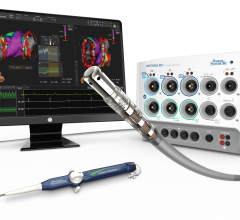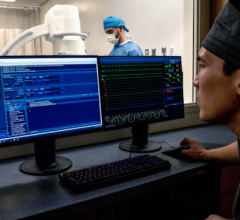October 3, 2011 —The American Society of Echocardiography (ASE) has published guidelines for new applications for echocardiography in the neonatal intensive care unit (NICU). An expert consensus statement, “Targeted Neonatal Echocardiography in the Neonatal Intensive Care Unit: Practice Guidelines and Recommendations for Training,” has been published in the October 2011 issue of JASE, the ASE’s monthly journal, and is also available online at: www.asecho/guidelines. The document defines the scope and appropriateness of echocardiography in the NICU and defines standards for both the echocardiographic examination and the individuals who perform and interpret these studies.
October 3, 2011 — Kjaya Medical will debut iShareScan.com, a cloud-based image sharing solution, at RSNA 2011. The site is available at no cost to imaging sites. It enables users to upload images to the Kjaya cloud, where they may be accessed, viewed and manipulated instantaneously in 2-D, 3-D or 4-D by authorized physicians utilizing the company’s advanced remote viewer.
October 3, 2011 – Up to now, on-the-job hazards for cardiac sonographers were usually limited to overtaxed muscles or incorrect body positioning. And the profession, with help from equipment manufacturers, has made remarkable progress in identifying and lessening these problems. But now, based on discussions initiated on the American Society of Echocardiography’s (ASE) social media website, [email protected] and results of an ASE survey, there appear to be growing concerns about radiation exposure. As October is Medical Ultrasound Awareness Month, the ASE believes it is appropriate to address this emerging concern for cardiovascular sonographers. Are sonographers getting more radiation on the job than is acceptable for their health?
Providing exceptional cardiovascular care for patients to achieve the best possible outcomes is the number one goal for ...
October 3, 2011 — JenaValve Technology GmbH, a German medical device company specializing in the development of transcatheter heart valve implantation (TAVI) systems, announced it has received CE mark approval for its transapical TAVI system of the second-generation. This system is used to treat severe aortic valve stenosis in elderly high-risk patients, especially in patients for whom conventional open-heart surgery is not an option.
October 3, 2011 – Cardiac Dimensions Inc. announced it received European CE mark approval for a newly enhanced version of its Carillon Mitral Contour System, a therapy for treating heart failure patients suffering from functional mitral regurgitation (FMR). Receipt of the CE mark enables Cardiac Dimensions to initiate a commercial launch of the enhanced device in Europe, which will begin in 2012.
October 3, 2011 – Boston Scientific has enrolled the first patients in its NECTAR-HF (NEural Cardiac TherApy foR Heart Failure) clinical trial. NECTAR-HF is a prospective, randomized, international clinical feasibility study designed to assess preliminary safety and efficacy of chronic vagal nerve stimulation in heart failure patients. The study will evaluate 96 patients with vagal nerve stimulator implants at multiple centers in Europe.
Cardiac positron emission tomography (PET) is growing in popularity among cardiologists because it provides the ability ...
October 3, 2011 – Researchers from MIT’s Computer Science and Artificial Intelligence Laboratory (CSAIL), the University of Michigan, Brigham and Women’s Hospital in Boston and Harvard Medical School have developed a new tool that can more accurately determine risk of death in patients who have suffered a heart attack. Results of the study could prove life saving for the millions of Americans who suffer heart attacks every year.
September 30, 2011 – Cambridge Heart Inc. announced its HearTwave II System was cleared for sale by the Mexican regulatory authorities. In August 2010, the company executed an exclusive distribution agreement with Mayerick S.A. de S.V. to distribute the system, including the company’s microvolt t-wave alternans (MTWA) software and micro-V alternans sensors. This addition represents the company’s first distribution agreement in Latin America.
September 30, 2011 — The American College of Cardiology Foundation (ACCF) and the American Heart Association (AHA) released an updated guideline for the diagnosis and management of peripheral artery disease (PAD). The goal is to help guide clinical decision-making related to PAD and improve patient outcomes.
When performing radiofrequency (RF) ablation to treat cardiac arrhythmia, medical professionals must balance the safety ...
September 30, 2011 — Boston Scientific Corp. said the U.S. Court of Appeals for the Federal Circuit found in favor of the company in a 1998 stent patent infringement suit involving Johnson & Johnson.
September 28, 2011 — Cardiac monitoring company Cardiac Network Inc., along with its joint venture partner Pacific Coast Innovations (PCI) LLC announced it is completing the work on its new Central Monitoring System (CMS). The new system, as described below, was built by the companies relating to the design of a new, technologically advanced monitoring device, related data storage and monitoring infrastructure.
September 28, 2011 — The 24th annual International Symposium on Endovascular Therapy (ISET) will take place Jan. 15-19, 2012, at the Fontainebleau Miami Beach. More than 1,500 members of the global endovascular community will be in attendance; this includes physicians, researchers, scientists, biomedical engineers, nurses, technologists and other industry professionals. The fields of interventional radiology, interventional cardiology and vascular surgery will be represented, among others.
Change Healthcare Cardiology Hemodynamics is an integrated hemodynamic monitoring system for monitoring vital signs and ...
September 28, 2011 — A clinical trial by Resverlogix Corp. is evaluating the early effects of a new drug compound in atherosclerotic plaque regression. The study is focused on patients with coronary artery disease who have a low level of high-density lipoprotein cholesterol (HDL-C).
September 28, 2011 –Ziehm Imaging said its holding company Aton GmbH acquired 100 percent of the United States-based mini C-arm specialist OrthoScan Inc.
T-wave alternans (TWA) refers to an alternating pattern in the T-wave of the electrocardiogram (ECG) and is recognized as a marker of electrical instability. Visible or macroscopic alternans was first reported in the context of proarrhythmic conditions including Prinzmetal’s angina and long QT syndrome, and was often found to immediately precede the onset of ventricular tachycardia or fibrillation. More recently, techniques have been developed to measure microvolt-level T-wave alternans (MTWA) not visible to the human eye. The presence of MTWA has been linked with increased risk of sudden cardiac arrest (SCA) in several patient populations. This study presents the case of a patient who experienced VF during the recovery phase of an MTWA stress test. While there was no visible abnormality on the ECG which would alert to the impending arrhythmia, significant microvolt-level alternans was detected immediately prior to the cardiac arrest.


 October 03, 2011
October 03, 2011














